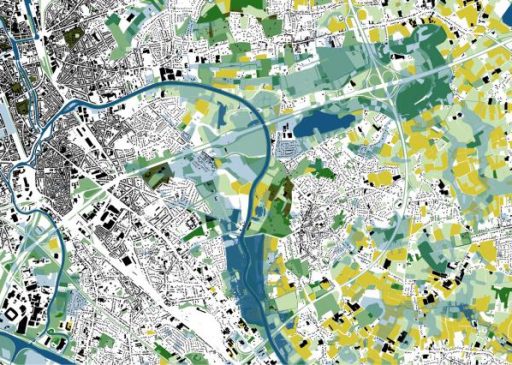Master studio’s Living the water landscape: Gentbrugse Meersen
Academiejaar 2017-2018
Onderdeel van het traject Vernieuwing van de stadsvernieuwingFrom 2017 until 2020, the Master Studio B will explore how we can (and how we must) transform our habitat, from the scale of the house, to the street, the neighborhood and the urban landscape, in order to meet the ambitious goals we have set in terms of climate change reduction. It thereby aims to move beyond the current paradox of climate adaptation and mitigation in most parts of the developed world. While the urgency of climate change is understood, we are still hoping that we do not need to change our ways of living, working and moving. We are collectively in favor of climate mitigation and adaptation, as long as it doesn’t come too close to our own lives and environment. We are postponing and even revolting against the adaptation of our habits, of our direct living environment. But at the same time we know with absolute certainty that we cannot change the climate (meaning: slow-down or reverse our current path of climate change), if we do not change the way we live, work and move – the way we use space.
The Master Studio Series Redrawing our Habitat to Change the Climate is organized as a laboratory for the reversal of that logic. More than drawing and visualizing the effects of technocratic fixing or cladding of our built environment (so that it consumes less energy, emits less CO2, etcetera), the studio will focus on a more systematic and fundamental transformation or ‘re-urbanization’ of houses, neighborhoods, allotment areas and parts of the urban landscape. The participants are challenged to formulate and visualize a transformation of the existing urbanization, both as a ‘local solution’ for the climate problem, and as a strong (and possibly desirable) proposition for the qualities our living environment can gain when adapting ourselves to change the climate.
Under this umbrella and collective ambition, the participants in the studio will approach the challenge and proposed site from different and specific vantage points, and from different scales at the same time: from the scale of the concrete intervention (architecture, public space, landscape) to the larger scale of the urban landscape. As all participants (alone or in groups) choose a specific perspective (such as current and future inhabitants, rationalizing mobility, retrofitting the existing building stock, water and sewage infrastructures, public space, etcetera) the studio becomes a conversation between different dimensions of, and propositions for, the redrawing of our habitat. The Master Studio sets a context for its participants to develop knowledge and visions, and become experts on the biggest challenge of the coming decades: we must invent a practice for the re-urbanization of our dispersed urban field.

